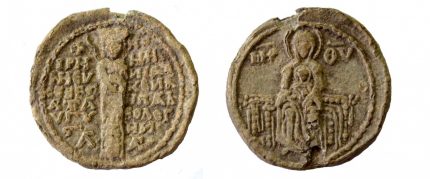Archaeologists excavating the medieval fortress of Lyutitsa near the town of Ivaylovgrad in southeastern Bulgaria have discovered a rare lead seal of Byzantine Empress Irene, consort of Emperor Andronicus II Palaeologus (r. 1282–1328). Only two other seals of Empress Irene are known to survive, both of them now in the British Museum. This is the only one of three to be found in Bulgaria.
The seal depicts Irene, born Yolande of Montferrat, on one side in her full regalia as Byzantine Empress. The other side is an image of the Virgin Mary seated with the Christ child on her lap. Irene’s name is stamped on both sides.
“The find is extremely valuable and shows that Lyutitsa was an important [medieval] Bulgarian city, whose governors had correspondence even with the rulers of the largest medieval states,” Bulgaria’s National Museum of History says.
Assoc. Prof. Vladimir Penchev, numismatist at the Museum, has pointed out that Yolande of Montferrat was Empress of Byzantium in 1284 – 1317.
Yolande of Montferrat was born in 1274 in the March of Montferrat (also known as Margraviate or Marquisate of Montferrat) in Northern Italy, a state of the Holy Roman Empire which became the Duchy of Montferrat in 1576.
Yolande was the daughter of William VII, Marquess of Montferrat, (1240 – 1292) and Beatrice of Castile (1254 – 1286), who was his second wife.
On her mother’s side, Yolande of Montferrat was the granddaughter of King Alfonso X the Wise of Castile (1221 – 1284) and Violante (Yolanda) of Aragon (1236 – 1301), after whom she was named. Alfonso X was the King of Castile, Leon, and Galicia in 1252 – 1284.
In 1284, the 10-year-old Yolande of Montferrat was married to the widowed Byzantine Emperor Andronicus II Palaeologus, upon which she converted to Eastern Orthodox Christianity, and adopted the name “Irene” meaning “peace”.

Catholic-Orthodox “arrangements” were not unheard of:
Θεοφάνια (“Theophanu” or “that Greek woman”), the niece of the Byzantine Emperor John I Tzimiskes, died in June of 991 at Nijmegen. She ruled the Holy Roman Empire as “west-roman” empress for a span of five years, from May 985 to 990.
She was criticized for her relative decadence (manifested in her bathing more than once a day and introducing new luxurious garments and jewelry into the royal court). Moreover, she is credited with introducing the fork to Western Europe :facepalm: